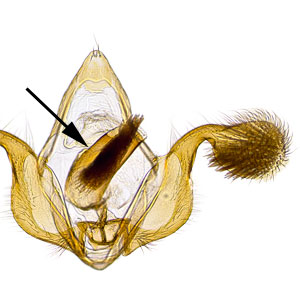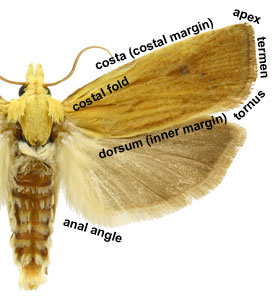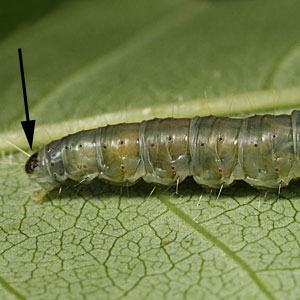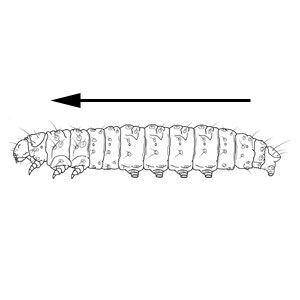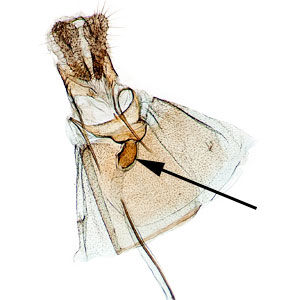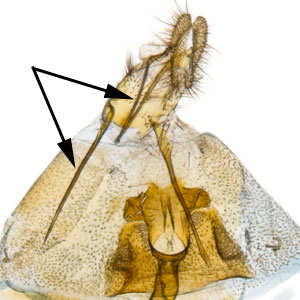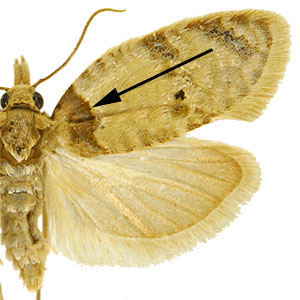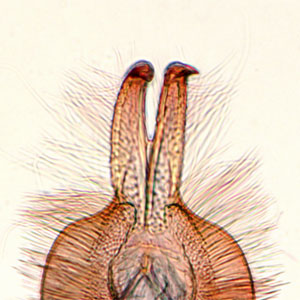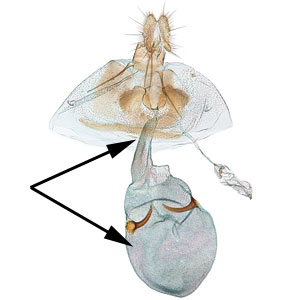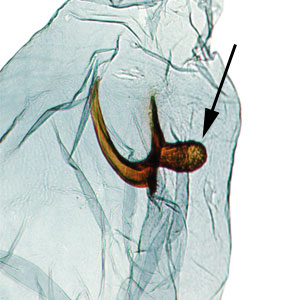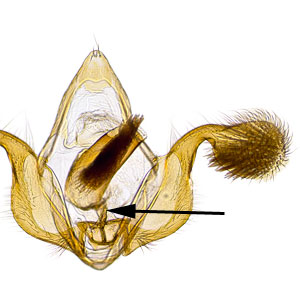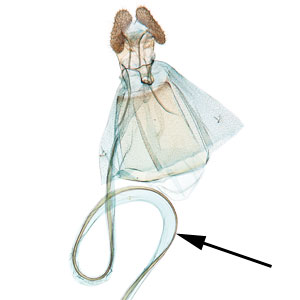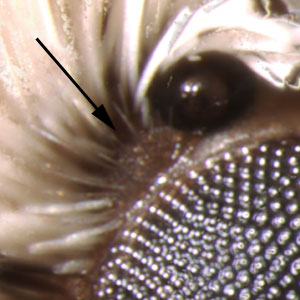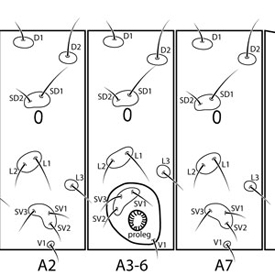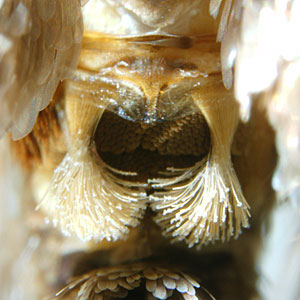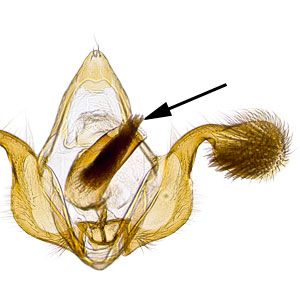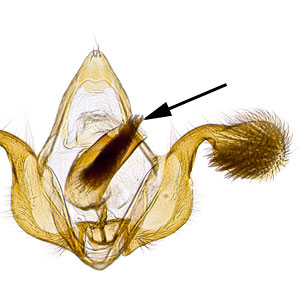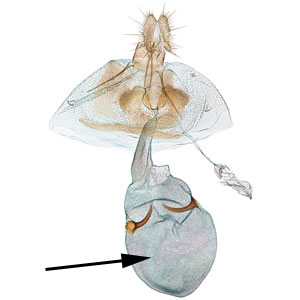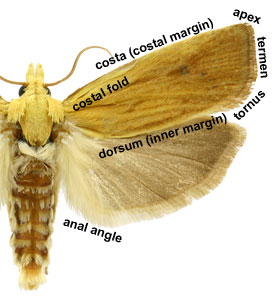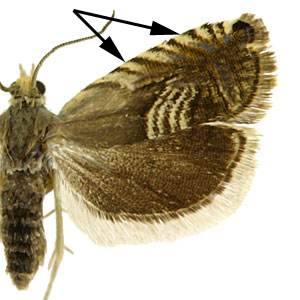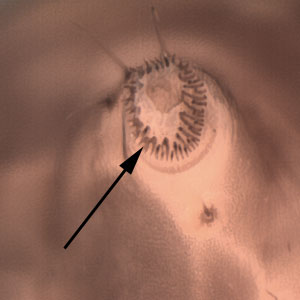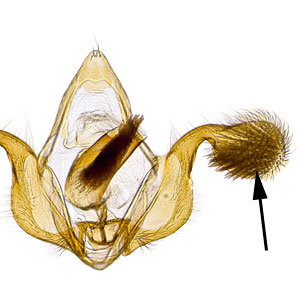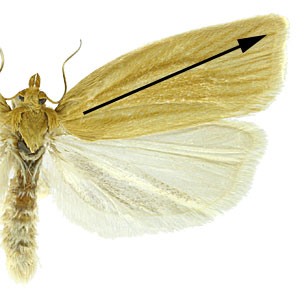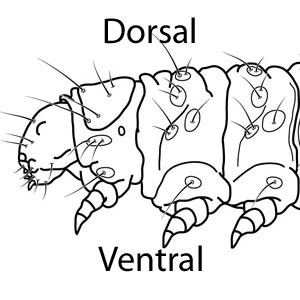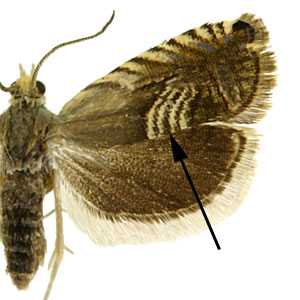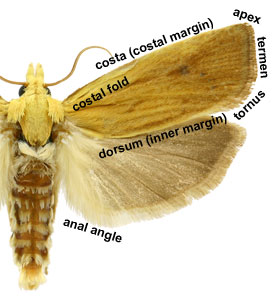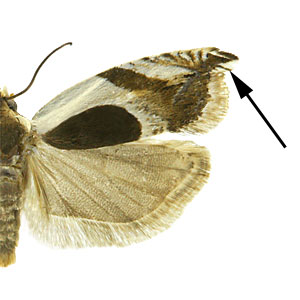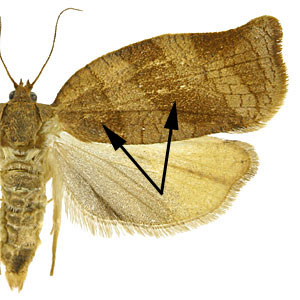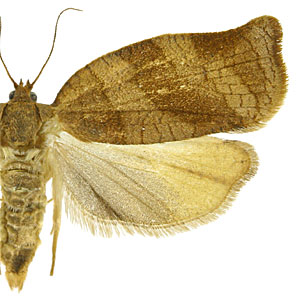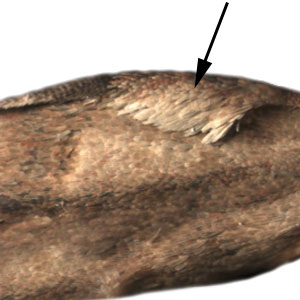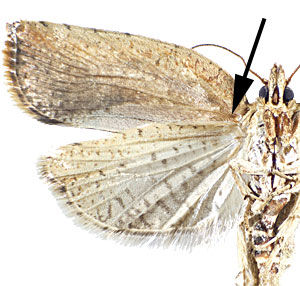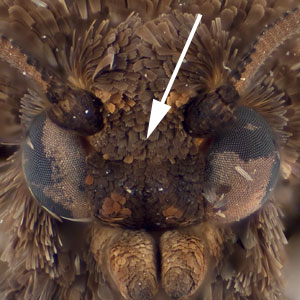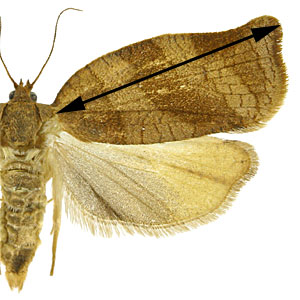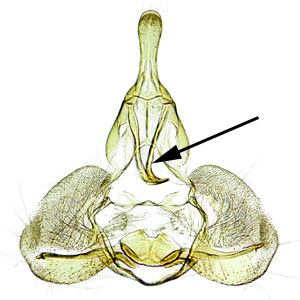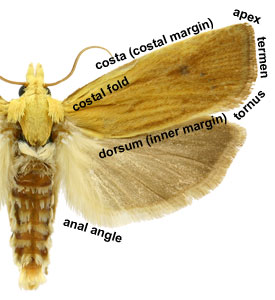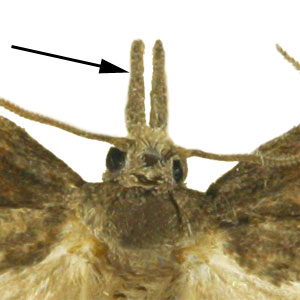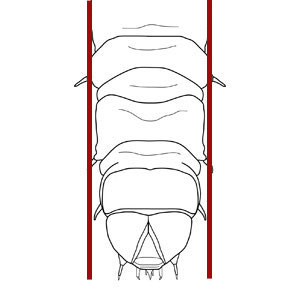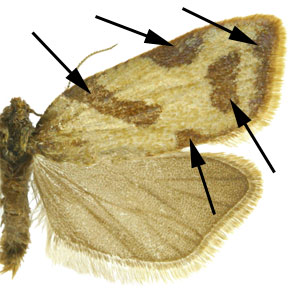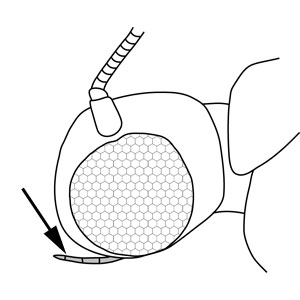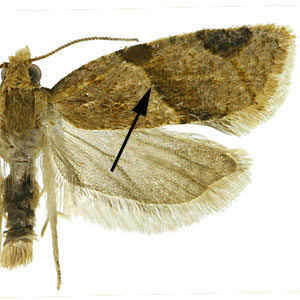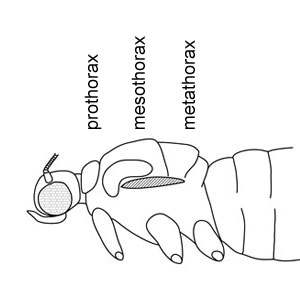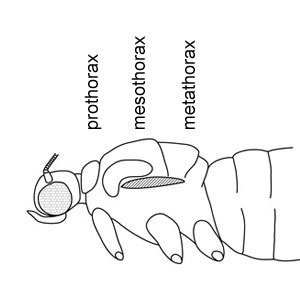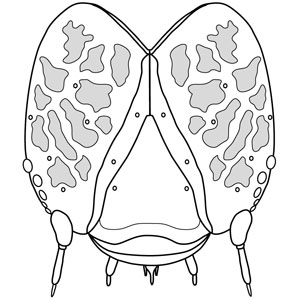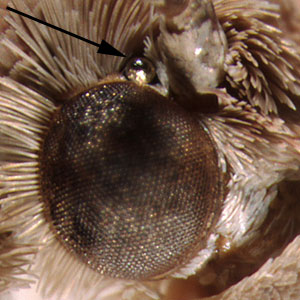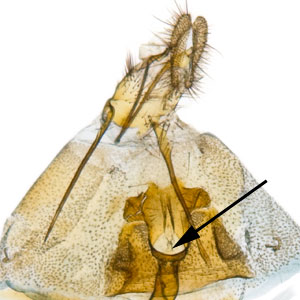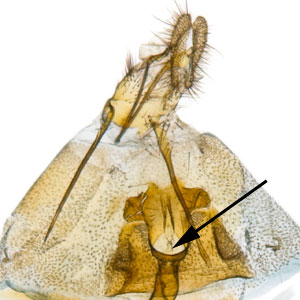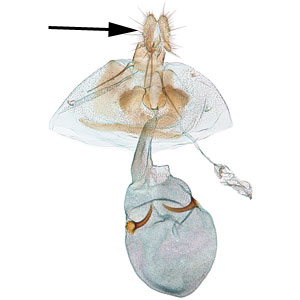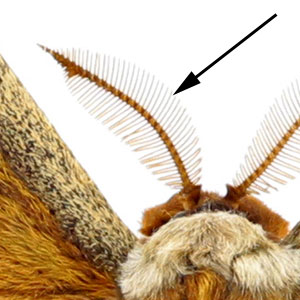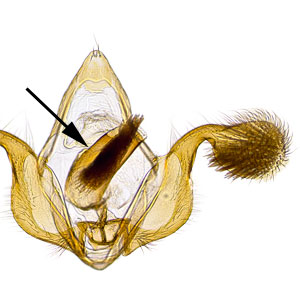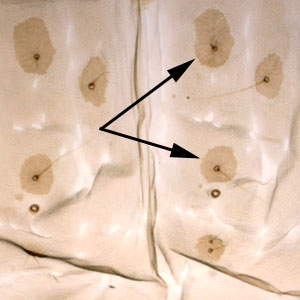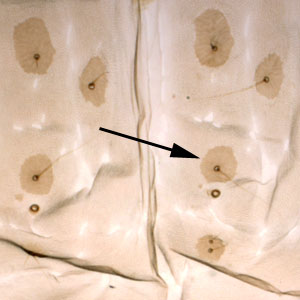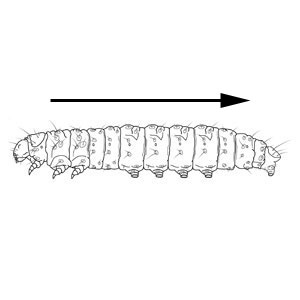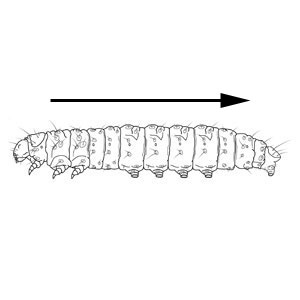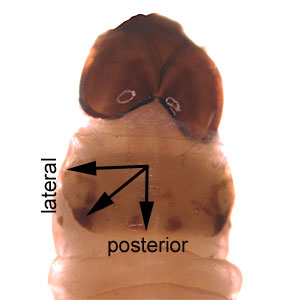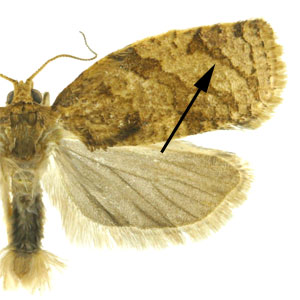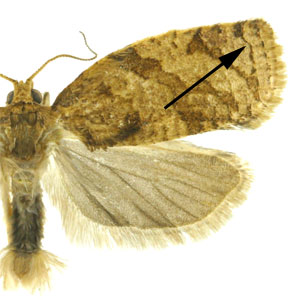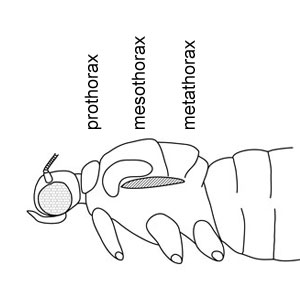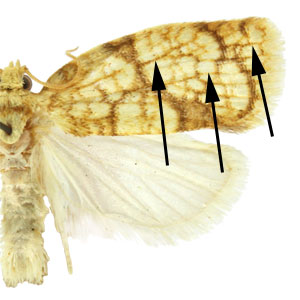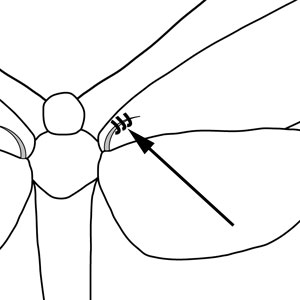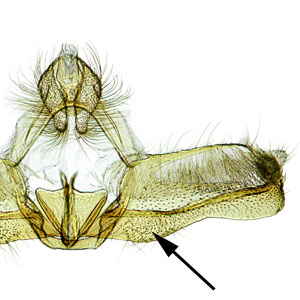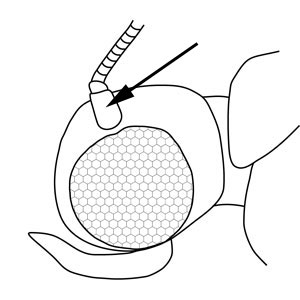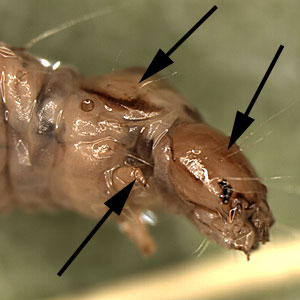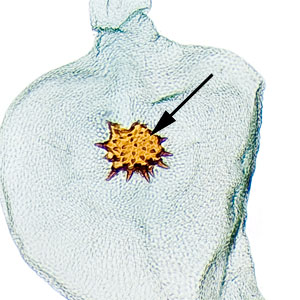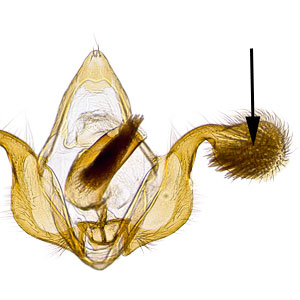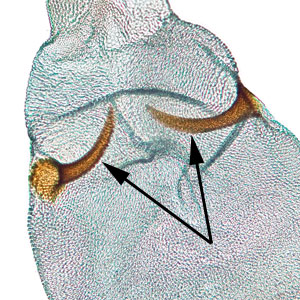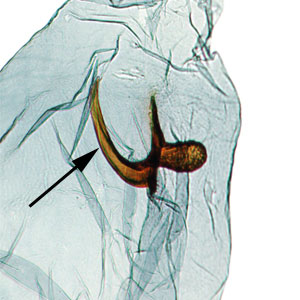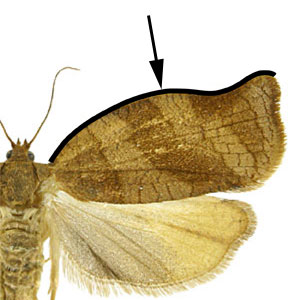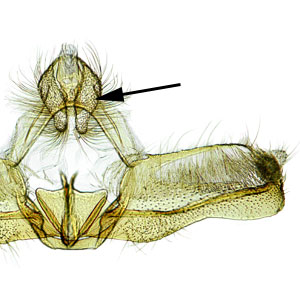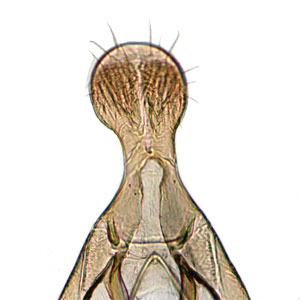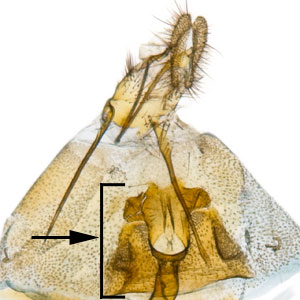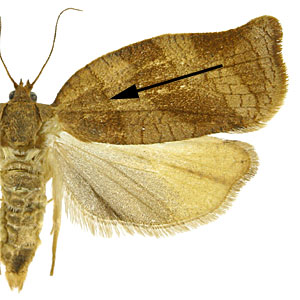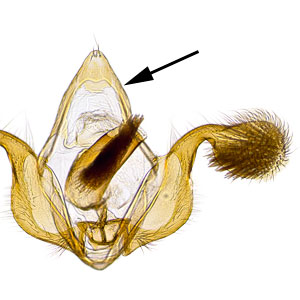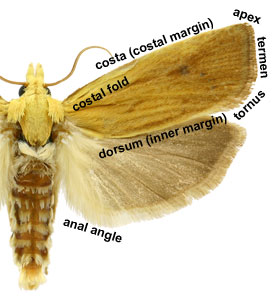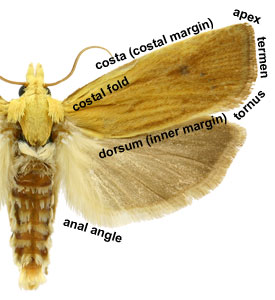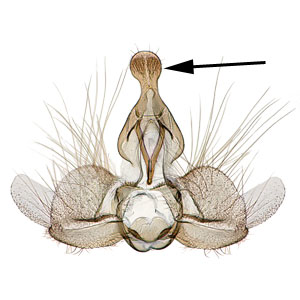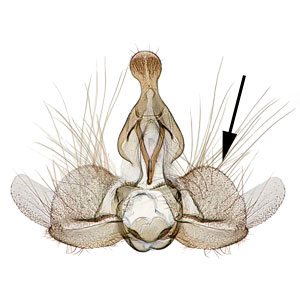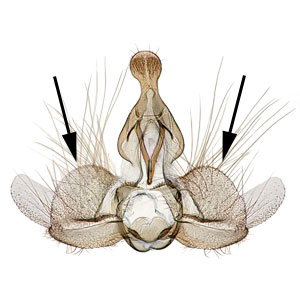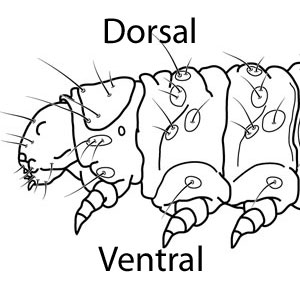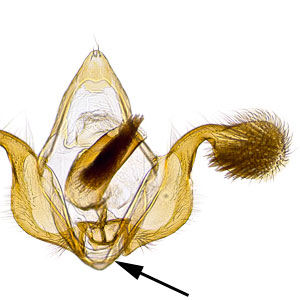A
aedeagus: the male intromittent organ (penis); see "phallus"
anal angle: on the hindwing, the angle nearest the end of the abdomen when the wings are expanded
anal comb: a toothed structure on the last abdominal segment used to eject frass away from the feeding larva; also termed "anal fork"
anal margin: see anal angle
anal shield: a sclerotized plate on the dorsal surface of the last abdominal segment (in larvae)
anellus: a variably cup-shaped sclerotized sheet surrounding the base of the aedeagus
anterior: before, to the front, toward the head
antrum: in the female genitalia; a funnellike sclerotization anterior to the ostium
apex: the point furthest removed from the base or at the end of the costal area
apophyses: apodemal rods used to extend the ovipositor; divided into the apophyses anteriores and apophyses posteriores
B
basal fascia: the fascia (transverse band) at the base of the forewing
bifid: cleft, forked, divided into two parts
bursa copulatrix: the female genital chamber that is divided into the ductus bursae and the corpus bursae
C
capitulum: in reference to the female signum; a knoblike projection
caulis: a rodlike plate connecting the juxta and anellus
cestum: a long, bandlike sclerotization of the wall of the ductus bursae
chaetosema: a small sensory organ located above the compound eye in some families of Lepidoptera (in adults)
chaetotaxy: the arrangement of setae (in reference to Lepidoptera larvae), often depicted on a "setal map"
coremata: specialized tufts of sex scales, usually found in the male (singular: corema)
cornuti: spines used to anchor the male vesica in the female bursa during copulation
cornutus: singular of "cornuti"
corpus bursae: a dilated membranous sac at the anterior end of the bursa copulatrix
costa: the anterior margin of each wing
costal margin: see costa
costal spot: a patch of contrasting scales on the costa, usually a remnant of the postmedian or preterminal fascia
costal strigulae: small, usually pale, semirectangular marks along the costa
crochets: hooked spines on the prolegs of lepidopterous larvae
cucullus: the distal portion of the male valva
D
dash: a short, sharp, black line on the forewing
distal: farthest from body, distant from point of attachment
dorsal: upper, to the top, on the back
dorsal strigulae: semirectangular pale marks or lines extending from the dorsal margin; usually expressed in the Grapholitini
dorsum: the lower or inner margin of the wing; the trailing edge of the forewing based on its position when the moth is in its resting posture
ductus bursae: a membranous tube connecting the ostium bursae to the corpus bursae
F
falcate: narrow, curved and pointed; sickle-shaped; shaped like a bird's beak
fascia: a dark transverse band on the forewing
fasciae: plural of "fascia"
filiform: threadlike, long and slender with uniform cross section
forewing costal fold: a flap or fold at the base of the forewing that contains specialized sex scales
frenulum: a single spine (males) or multiple spines (females) that project anteriorly from the base of the hindwing; used to couple the hindwings to the forewings in flight by means of a retinaculum on the forewing
frons: the upper anterior portion of the head (in adults)
FWL: forewing length; the distance from the base of the forewing to the apex, including fringe
G
gnathos: a narrow bandlike structure that joins the posterolateral edges of the tegumen and supports the anal tube
I
inner margin: see dorsum
L
labial palpi: a pair of sensory appendages that project from the lower part of the head; usually covered in scales and three-segmented
lateral: to the side
lustrous: bright, shining, metallic
M
maculation: markings, pattern of spots, bands, blotches, streaks, etc.; wing markings
maxillary palpi: a pair of segmented appendages extending from the lower part of the head; usually smaller than the labial palpi and may be reduced or absent in some families
medial: to the middle, center, toward center line
median fascia: the fascia (transverse band) in the middle of the forewing, delimited by costal strigulae pairs 4 and 5
mesothorax: the middle segment of the thorax
metathorax: the most posterior thoracic segment
mottled: having spots or blotches of color
O
ocelli: adult head - a simple insect "eye" located dorsal to the compound eye; plural of ocellus
ocellus: forewing pattern element - an ovoid region anterior to the tornus; adult head - a simple insect "eye" located dorsal to the compound eye
ostium: see ostium bursae
ostium bursae: the female copulatory orifice; the entrance to the bursa copulatrix
P
papillae anales: the female ovipositor lobes
pecten: a comblike or rakelike structure located on the first antennal segment (in adults)
pectinate: with branches or processes like the teeth of a comb
phallus: the male intromittent organ (penis); see "aedeagus"
pinacula: flattened sclerotized plates on a caterpillar that bear the setae
pinaculum: singular of "pinacula"
porrect: extending forward horizontally
posterad: towards the posterior
posterior: after, to the rear, toward anal end
posterolateral: towards the rear and side; posterior and lateral
postmedian fascia: the fascia (transverse band) beyond the middle of the forewing, delimited by costal strigulae pairs 6 and 7
preterminal fascia: the fascia (transverse band) near the apex of the forewing, delimited by costal strigulae pairs 8 and 9
prothoracic shield: a sclerotized plate on the dorsal surface of the prothorax
prothorax: the most anterior thoracic segment
proximal: toward the base, nearest the body or point of attachment
R
reticulations: covered with a network of lines or mesh; in reference to wing pattern, usually thin horizontal lines
retinaculum: a hook or series of bristles on the underside of the forewing used to engage the frenulum to couple the front and hind wings
S
sacculus: the ventral margin of the male valva
saddle: in reference to the D2 pinacula on larval segment A9; both setae are on a single, fused pinaculum in the mid-dorsal region of the segment
scape: the basal segment of an insect antenna
sclerotized: hardened; usually in reference to larval structures or adult genitalia
scobinate: rasplike
setose: covered with setae
signa: plural of "signum"
signum: a sclerotized projection or patch on the interior of the corpus bursae
sinuate: a curved or wavy margin
socii: a pair of lightly sclerotized setose lobes
spatulate: spoonlike, narrow basally and enlarged and rounded apically
sterigma: the sclerotized region surrounding the female ostium bursae
subbasal fascia: the fascia (transverse band) near the base of the forewing, delimited by costal strigulae pairs 2 and 3
T
tegumen: dorsal section of the transverse ring in male genitalia; often heavily sclerotized
termen: the outer edge of the forewing
tornus: the junction of the termen and dorsum of the wing
tympanum: a membrane-covered cavity that serves as a hearing organ (not present in Tortricidae)
U
uncus: a sclerotized process which is fused to the posterodorsal margin of tergum IX
V
valva: an appendage flanking the intromittent organ that is used to clasp the female during copulation
valvae: plural of "valva"
ventral: lower, to the bottom, on the under side
vinculum: ventral section of the transverse ring in male genitalia

